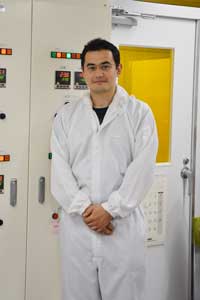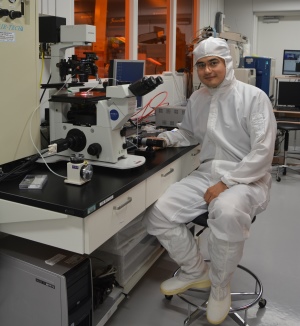Nov. 11, 2016
Miniaturizing experiments
Yaxiaer Yalikun, Postdoctoral Researcher

Laboratory for Integrated Biodevice, RIKEN Quantitative Biology Center
Please describe your role at RIKEN.
I mainly support other teams at the RIKEN Quantitative Biology Center by developing microfabrication technologies and microfluidic devices that can be used in biology, chemistry and medicine. I also come up with solutions for enhancing the efficiency of experiments, minimizing the size of conventional experimental systems, and designing mini labs on tiny chips.
Please briefly describe your current research.
I develop technologies for handling, manipulating and stimulating small objects, solutions, and single cells. These technologies enable an entire experimental setup to be placed close to where the samples are prepared, which reduces cost, enables miniaturization and cuts analysis time. Our research requires background knowledge in many disciplines, including chemistry, biochemistry, mechanics and materials engineering.
How did you become interested in your current research field?
I majored in mechanical engineering at university and worked as an electrical engineer in my previous job. I later discovered that all of the technologies I had mastered can be applied to the development of microelectromechanical systems, which can be used to explore fundamental biological phenomena.
What excites you the most about your current research?
I play an indispensable role in the scientific journeys of many research teams. Nothing is more fulfilling than seeing the devices I fabricate being used to observe things we could never see before.
What has been one of your most important research achievements?

I established a method using femtosecond-laser processing to fabricate a flexible microfluidic chip, which is only 12 micrometers thick and made entirely out of glass. The method reduces the thickness limitation of fabricating flexible glass devices, which can be used for targeted drug delivery to the brain, implantable medical devices, wearable technologies and high-resolution imaging of small biological objects such as bacteria and proteins. Having set a world record once, I now want all of my research endeavors to set new world records.
How has being at RIKEN helped your research?
The researchers in my laboratory are leading experts in a wide range of fields. I learn something new from them every day and have started to think from different viewpoints.
What is the best thing about working at RIKEN?
I can decide what areas I want to focus on and chase my own dreams. Only in RIKEN it is possible for me to come up with an idea, discuss it with world-class researchers and then immediately get to work on realizing it in state-of-the-art facilities. We even have access to an electron-beam lithography system that can draw 10-nanometer thin lines and patterns on a chip.
What do you wish you had known before coming to RIKEN?
I am originally from Xinjiang Uyghur Autonomous Region in China. I joined RIKEN in May 2015 and in April 2017 will become a Special Postdoctoral Researcher. I just wish I had moved here several years earlier.
Please tell us about your professional goals.
I want to continue to do what I enjoy—offering critical technologies and devices for discovering new and unknown principles in biological systems.
